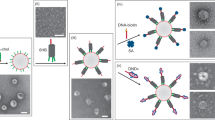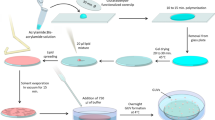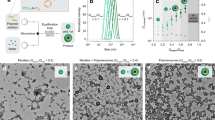Abstract
Unilamellar polymer vesicles are formed when a block copolymer self-assembles to form a single bilayer structure, with a hydrophobic core and hydrophilic surfaces, and the resulting membrane folds over and rearranges by connecting its edges to enclose a space. The physics of self-assembly tightly specifies the wall thickness of the resulting vesicle, but, both for polymer vesicles and phospholipids, no mechanism strongly selects for the overall size, so the size distribution of vesicles tends to be very polydisperse. We report a method for the production of controlled size distributions of micrometre-sized (that is, giant) vesicles combining the ‘top-down’ control of micrometre-sized features (vesicle diameter) by photolithography and dewetting with the ‘bottom-up’ control of nanometre-sized features (membrane thickness) by molecular self-assembly. It enables the spontaneous creation of unilamellar vesicles with a narrow size distribution that could find applications in drug and gene delivery, nano- and micro-reactors, substrates for macromolecular crystallography and model systems for studies of membrane function.
This is a preview of subscription content, access via your institution
Access options
Subscribe to this journal
Receive 12 print issues and online access
$259.00 per year
only $21.58 per issue
Buy this article
- Purchase on Springer Link
- Instant access to full article PDF
Prices may be subject to local taxes which are calculated during checkout




Similar content being viewed by others
References
Kita-Tokarczyk, K., Grumelard, J., Haefele, T. & Meier, W. Block copolymer vesicles—using concepts from polymer chemistry to mimic biomembranes. Polymer 46, 3540–3563 (2005).
Discher, D. E. & Eisenberg, A. Polymer vesicles. Science 297, 967–973 (2002).
Lipowsky, R. The conformation of membranes. Nature 349, 475–481 (1991).
Battaglia, G. & Ryan, A. J. Bilayers and interdigitation in block copolymer vesicles. J. Am. Chem. Soc. 127, 8757–8764 (2005).
Matsen, M. W. & Bates, F. S. Origins of complex self-assembly in block copolymers. Macromolecules 29, 7641–7644 (1996).
Battaglia, G. & Ryan, A. J. Effect of amphiphile size on the transformation from a lyotropic gel to a vesicular dispersion. Macromolecules 39, 798–805 (2006).
Battaglia, G., Ryan, A. J. & Tomas, S. Polymeric vesicle permeability: A facile chemical assay. Langmuir 22, 4910–4913 (2006).
Lin, J. J. et al. The effect of polymer chain length and surface density on the adhesiveness of functionalized polymersomes. Langmuir 20, 5493–5500 (2004).
Lin, J. J., Bates, F. S., Hammer, D. A. & Silas, J. A. Adhesion of polymer vesicles. Phys. Rev. Lett. 95, 026101 (2005).
Lin, J. J., Ghoroghchian, P., Zhang, Y. & Hammer, D. A. Adhesion of antibody-functionalized polymersomes. Langmuir 22, 3975–3979 (2006).
Photos, P. J., Bacakova, L., Discher, B., Bates, F. S. & Discher, D. E. Polymer vesicles in vivo: Correlations with PEG molecular weight. J. Control. Release 90, 323–334 (2003).
Ahmed, F. & Discher, D. E. Self-porating polymersomes of PEG-PLA and PEG-PCL: Hydrolysis-triggered controlled release vesicles. J. Control. Release 96, 37–53 (2004).
Szoka, F. & Papahadjopoulos, D. Procedure for preparation of liposomes with large internal aqueous space and high capture by reverse-phase evaporation. Proc. Natl Acad. Sci. USA 75, 4194–4198 (1978).
Moscho, A., Orwar, O., Chiu, D. T., Modi, B. P. & Zare, R. N. Rapid preparation of giant unilamellar vesicles. Proc. Natl Acad. Sci. USA 93, 11443–11447 (1996).
Kabanov, A. V., Bronich, T. K., Kabanov, V. A., Yu, K. & Eisenberg, A. Spontaneous formation of vesicles from complexes of block ionomers and surfactants. J. Am. Chem. Soc. 120, 9941–9942 (1998).
Luo, L. B. & Eisenberg, A. Thermodynamic size control of block copolymer vesicles in solution. Langmuir 17, 6804–6811 (2001).
Luo, L. B. & Eisenberg, A. Thermodynamic stabilization mechanism of block copolymer vesicles. J. Am. Chem. Soc. 123, 1012–1013 (2001).
Choucair, A. & Eisenberg, A. Control of amphiphilic block copolymer morphologies using solution conditions. Eur. Phys. J. E 10, 37–44 (2003).
Shen, H. W. & Eisenberg, A. Morphological phase diagram for a ternary system of block copolymer PS310-b-PAA(52)/dioxane/H2O. J. Phys. Chem. B 103, 9473–9487 (1999).
Gregoriadis, G. Liposome Technology. Vol. I: Preparation of Liposomes (CRC Press, 1984).
Angelova, M. I. & Dimitrov, D. S. Liposome electroformation. Faraday Discuss. Chem. Soc. 81, 303–311 (1986).
Menger, F. M. & Angelova, M. I. Giant vesicles: Imitating the cytological processes of cell membranes. Acc. Chem. Res. 31, 789–797 (1998).
Olson, F., Hunt, C. A., Szoka, F. C., Vail, W. J. & Papahadjopoulos, D. Preparation of liposomes of defined size distribution by extrusion through polycarbonate membranes. Biochim. Biophys. Acta 557, 9–23 (1979).
Jain, S. & Bates, F. S. Consequences of nonergodicity in aqueous binary PEO-PB micellar dispersions. Macromolecules 37, 1511–1523 (2004).
Taylor, P., Xu, C., Fletcher, P. D. I. & Paunov, V. N. A novel technique for preparation of monodisperse giant liposomes. Chem. Commun. 14, 1732–1733 (2003).
Battaglia, G. & Ryan, A. J. The evolution of vesicles from bulk lamellar gels. Nature Mater. 4, 869–876 (2005).
Hauschild, S. et al. Direct preparation and loading of lipid and polymer vesicles using inkjets. Small 1, 1177–1180 (2005).
LoPresti, C., Lomas, H., Massignani, M., Smart, T. & Battaglia, G. Polymersomes: Nature inspired nanometer sized compartments. J. Mater. Chem. (in the press, 2008).
Leggett, G. J. Scanning near-field photolithography-surface photochemistry with nanoscale spatial resolution. Chem. Soc. Rev. 35, 1150–1161 (2006).
Acknowledgements
J.R.H. thanks the EPSRC for financial support, R.E.D. is grateful to the BBSRC, G.J.L. thanks the RSC Analytical Chemistry Trust Fund and the EPSRC for support and A.J.R. thanks ICI plc.
Author information
Authors and Affiliations
Corresponding authors
Rights and permissions
About this article
Cite this article
Howse, J., Jones, R., Battaglia, G. et al. Templated formation of giant polymer vesicles with controlled size distributions. Nature Mater 8, 507–511 (2009). https://doi.org/10.1038/nmat2446
Received:
Accepted:
Published:
Issue Date:
DOI: https://doi.org/10.1038/nmat2446
This article is cited by
-
Dynamic metastable polymersomes enable continuous flow manufacturing
Nature Communications (2023)
-
Tunable and scalable fabrication of block copolymer-based 3D polymorphic artificial cell membrane array
Nature Communications (2022)
-
Synthetic protein-conductive membrane nanopores built with DNA
Nature Communications (2019)
-
Ca-Mediated Electroformation of Cell-Sized Lipid Vesicles
Scientific Reports (2015)
-
Efficient repairing effect of PEG based tri-block copolymer on mechanically damaged PC12 cells and isolated spinal cord
Journal of Materials Science: Materials in Medicine (2014)



